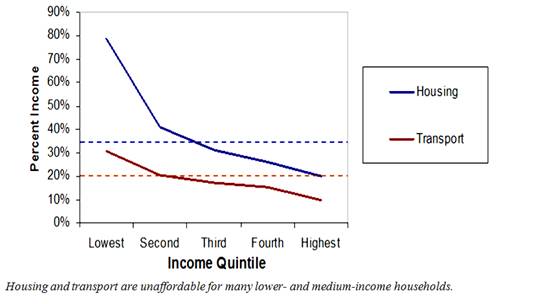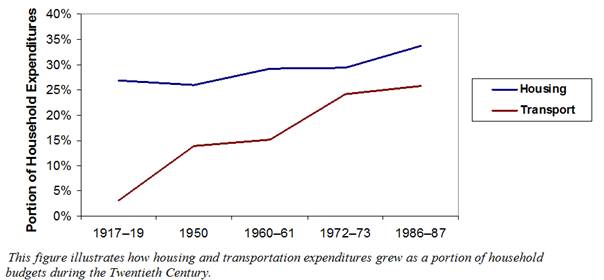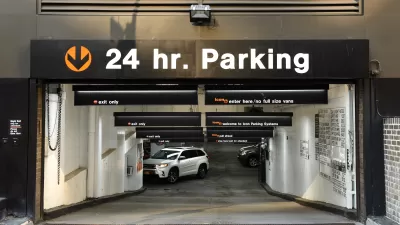Why are otherwise generous and smart people sometimes selfish and irrational?
Why are otherwise generous and smart people sometimes selfish and irrational?
Planners are change managers; it is our job to help people identify, understand and implement appropriate reforms. To be successful, it is important to understand resistance to beneficial change. One barrier I frequently encounter is motorists' opposition to more multi-modal planning and efficient pricing that could benefit them overall.
For example, like many cities, Vancouver is working to create a more diverse and efficient transport system. Vancouver's efforts have been pretty successful: automobile mode share has declined, due in part to walking, cycling and public transit infrastructure improvements. Yet, motorists continue to oppose new bike lanes, arguing that cyclists pay an insufficient share of roadway costs. In a recent interview with Vancouver newspaper columnist Don Cayo, I pointed out that local roads are mainly funded by general taxes that residents pay regardless of how they travel, and since motorists impose higher roadway costs per kilometer of travel and tend to travel more annual kilometers than people who rely on other modes, it is motorists who underpay their infrastructure costs. This column generated an unusually large number of responses (119 at last count), many quite angry at the suggestion that motorists underpay or that the city should continue to invest in alternative modes.
Yet, this is tame compared with responses to proposals for road pricing, parking fees and increased fuel taxes. These reforms are efficient and fair, and consumers willingly pay for most of the other goods they use, but motorists react with irrational fear and anger when anybody suggests that they should pay directly for roads and parking. Let's investigate why.
Money
Automobile transportation is costly. It requires a vehicle, fuel, roads and multiple parking facilities. Most motorists only consider their vehicle and fuel expenses, they know little about these other costs. Here is how they compare.
According to the U.S. Consumer Expenditure Survey, in 2008 U.S. motorists spent on average approximately $2,700 per vehicle on ownership expenses (purchase, registration, insurance, etc.) and $1,400 on fuel and oil, about $4,100 in total. That year, governments spent $181 billion to build and maintain roadways (more if you include traffic services such as policing and emergency response), or about $730 annually per registered motor vehicle. Less than half of these roadway expenses are paid by motor vehicle user fees, the rest are borne through general taxes. Expanding urban highways typically costs $0.50 to $1.50 per additional peak-period vehicle-mile, so accommodating an additional urban automobile commuter without increasing congestion, for example, adding 20 lane-miles of urban highway, typically costs $10 to $30 per day in additional construction and operating expenses.
A typical urban parking space costs $5,000 to $25,000 to construct, resulting in $500 to $1,500 in annualized construction and operating costs. There are estimated to be at least three off-street parking spaces per vehicle worth about $3,000 annually in total per vehicle. This indicates that most vehicles are worth less than the road and parking infrastructure required for their use. For each dollar that a motorist spends on their vehicle, governments, businesses and consumers must spend at least another dollar to provide roads and parking facilities for their use.
If motorists were to pay directly for these facilities, as required for efficiency and equity, their user charges would approximately double. Yet, many motorists are already financially stressed. The graph below illustrates the portion of household budgets devoted housing and transport by income class. Housing and transport expenses exceed the recommended limits (33% for housing and 20% for transport, or 45% combined) for the two lowest income quintiles (40% of the U.S. population). Since zero-vehicle households spend relatively little on transport, transportation inaffordability is even worse than this graph indicates for the 77.5% of these lower-income households that own motor vehicles. In other words, "affordable automobile dependency" is an oxymoron: You can have affordable transportation or you can have automobile dependency, but it is impossible to have both, and efforts to make driving "affordable" simply shift the costs to other economic sectors, such as government, businesses, or housing.
Housing and Transport Expenditures by Income Quintile

Transportation costs are not always so burdensome. The graph below shows how transportation costs have increased during the last century, due to increased automobile ownership and use. Similar patterns exist geographically: households in more multi-modal communities spend much less on transport than those in automobile-oriented areas. It is perfectly possible to make housing and transport much more affordable than what is available to most North American households.
Housing & Transport Expenditure Trends

This explains why motorists so selfish and irrational. They think, "I'm already spending more than I can afford to drive, higher fees would really make me suffer." So motorists demand subsidies: cheap fuel, unpriced roads, free parking, and limits on crash compensation. From some perspectives these subsidies seem reasonable and fair since individually they seem modest, they are mostly borne by motorists as a group, and measured per passenger-mile are often smaller than public transit subsidies. However, in total they are large, they force people who drive less than average to subsidize the transportation costs of otherwise comparable neighbors who drive more than average, and since motorists tend to travel more annual miles than people who rely on other modes they receive much greater subsidies per capita.
Space
Automobile travel is also space-intensive. The space requirements of different modes can be compared using time-area analysis, the product of space times time, measured in square-foot-minutes. Parking requirements depend on vehicle size. Travel space requirements depend on vehicle size and speed, since faster vehicles need more shy distance between them and other objects. For example, an automobile traveling at 30 miles-per-hour (mph) requires about 12.5 feet of lane width and 80 feet of lane length, or about 1,000 square feet in total, but at 60 mph this increases to 15 feet of lane width and 150 feet of length, about 2,250 square feet. The table below compares the time-area requirements of various modes for a 20-minute commute with 8 hours of vehicle parking. This indicates that driving requires about 15 times more space than bicycling, about 50 times more than public transport, and about 100 times more than walking.

Creating more bus, HOV and bike lanes is efficient and fair, because it allows users of these space-efficient modes (walking, cycling and public transit) to avoid delays caused by space intensive modes (single-occupant vehicles), and by making these modes more competitive it can attract travelers out of their cars which reduces traffic and parking congestion and parking problems. Yet, motorists often oppose such conversions. They only perceive congestion as a problem they face rather than a problem they cause, and they cannot imagine changing their own travel patterns to benefit others.
If motorists were generous and rational they would say things such as:
"Let's create a transportation system that serves everybody."
"Automobile travel does require a lot of road space, so it makes sense to favor more space efficient modes under congested conditions."
"I support bike and bus lane development. Even if I do not use these facilities now, I benefit if other travelers shift to these modes, and I may want to use them sometime in the future."
"I realize that the roads and parking facilities I use are costly to build and operate. It's better that we pay for them directly through user fees rather than indirectly through subsidies that everybody must bear."
Solutions
Pity the suffering motorist. Many already spend more than they can afford on their vehicles, yet driving is often tedious and stressful. No wonder they are frustrated.
The root of the problem is automobile dependency, which makes automobile transport a necessity. This creates a cycle of increased vehicle travel, reduced transport options, increased transport costs, and an inability to imagine alternatives to driving. Automobile dependency increases the cost of living, so what would otherwise be considered a reasonable income becomes inadequate. We should not blame the motorist. Automobile dependency is comparable to an addiction which causes otherwise generous and smart people to become selfish and irrational.
I am not suggesting that everybody must give up driving altogether. My research and my personal experience indicate that the best transport system is multi-modal: good walking and cycling conditions; good public transit, carsharing and taxi services; and mixed land use to minimize the distances people must travel to reach common services and activities. This is no more "anti-automobile" than a healthy diet is "anti-food," it lets users choose the best mode for each trip. I do not believe that people should be forced to live in such communities, but housing in such neighborhoods should be available to anybody who wants, including those with low incomes, and people who drive less than average should not be forced to subidize people who drive more than average.
There are two possible responses to the high costs of driving. We can continue to increase road, parking and fuel subsidies in an attempt to keep automobile travel affordable. However, this entails huge costs, is unfair to people who drive less than average, and exacerbates problems such as traffic congestion, accidents and pollution. Alternatively, we can create a more diverse and efficient transport system. This requires shifting some road space to alternative modes and increasing vehicle fees. By reducing the amount that people must drive to satisfy their needs this approach reduces total transport costs, reduces traffic problems, and provides other benefits to users and society.
Our challenge is to help those unhappy motorists realize that they could benefit from a more generous and rational response to their problems. What do you recommend?

Alabama: Trump Terminates Settlements for Black Communities Harmed By Raw Sewage
Trump deemed the landmark civil rights agreement “illegal DEI and environmental justice policy.”

Planetizen Federal Action Tracker
A weekly monitor of how Trump’s orders and actions are impacting planners and planning in America.

The 120 Year Old Tiny Home Villages That Sheltered San Francisco’s Earthquake Refugees
More than a century ago, San Francisco mobilized to house thousands of residents displaced by the 1906 earthquake. Could their strategy offer a model for the present?

In Both Crashes and Crime, Public Transportation is Far Safer than Driving
Contrary to popular assumptions, public transportation has far lower crash and crime rates than automobile travel. For safer communities, improve and encourage transit travel.

Report: Zoning Reforms Should Complement Nashville’s Ambitious Transit Plan
Without reform, restrictive zoning codes will limit the impact of the city’s planned transit expansion and could exclude some of the residents who depend on transit the most.

Judge Orders Release of Frozen IRA, IIJA Funding
The decision is a victory for environmental groups who charged that freezing funds for critical infrastructure and disaster response programs caused “real and irreparable harm” to communities.
Urban Design for Planners 1: Software Tools
This six-course series explores essential urban design concepts using open source software and equips planners with the tools they need to participate fully in the urban design process.
Planning for Universal Design
Learn the tools for implementing Universal Design in planning regulations.
Clanton & Associates, Inc.
Jessamine County Fiscal Court
Institute for Housing and Urban Development Studies (IHS)
City of Grandview
Harvard GSD Executive Education
Toledo-Lucas County Plan Commissions
Salt Lake City
NYU Wagner Graduate School of Public Service






























